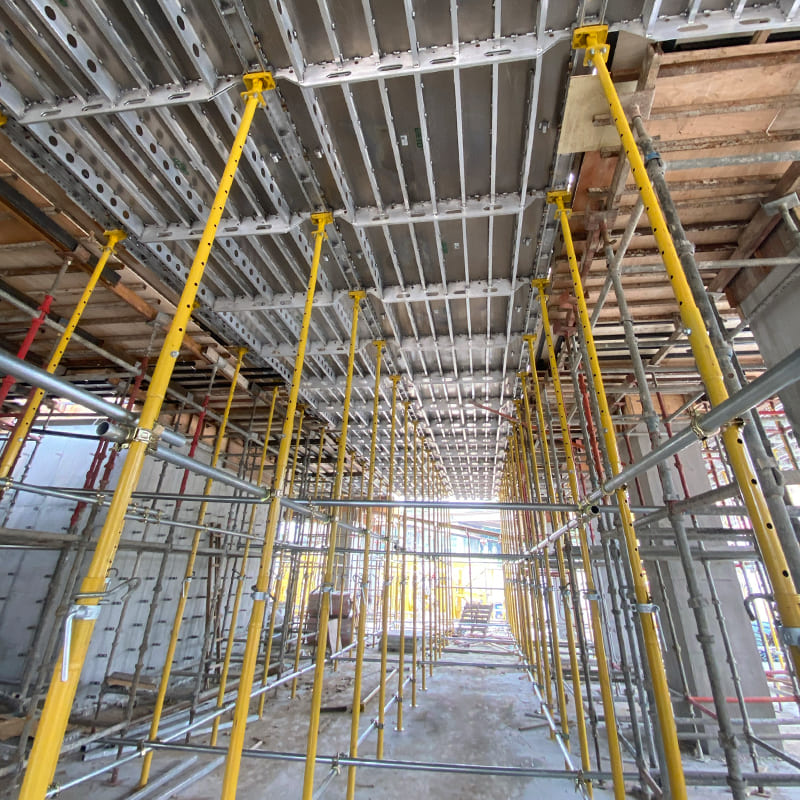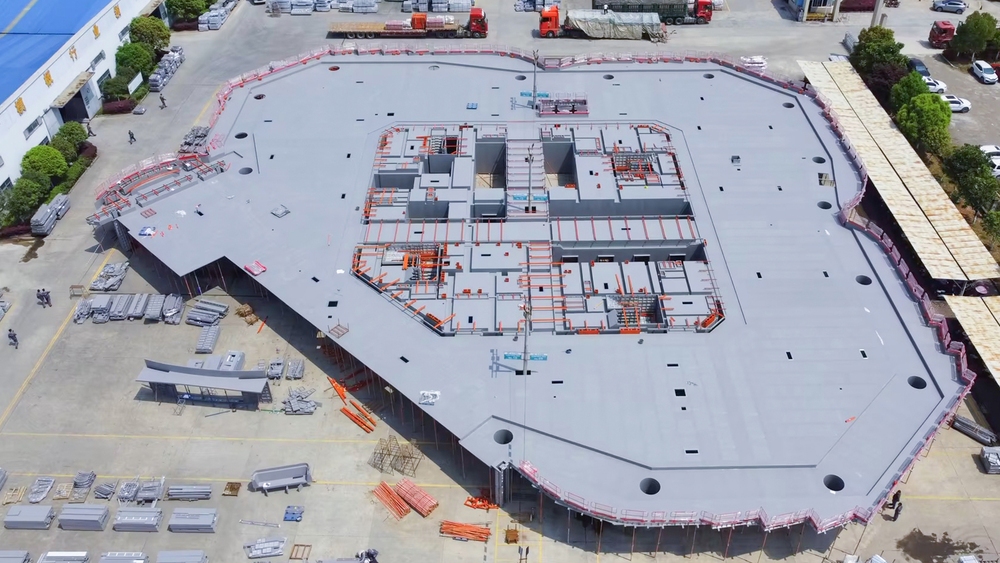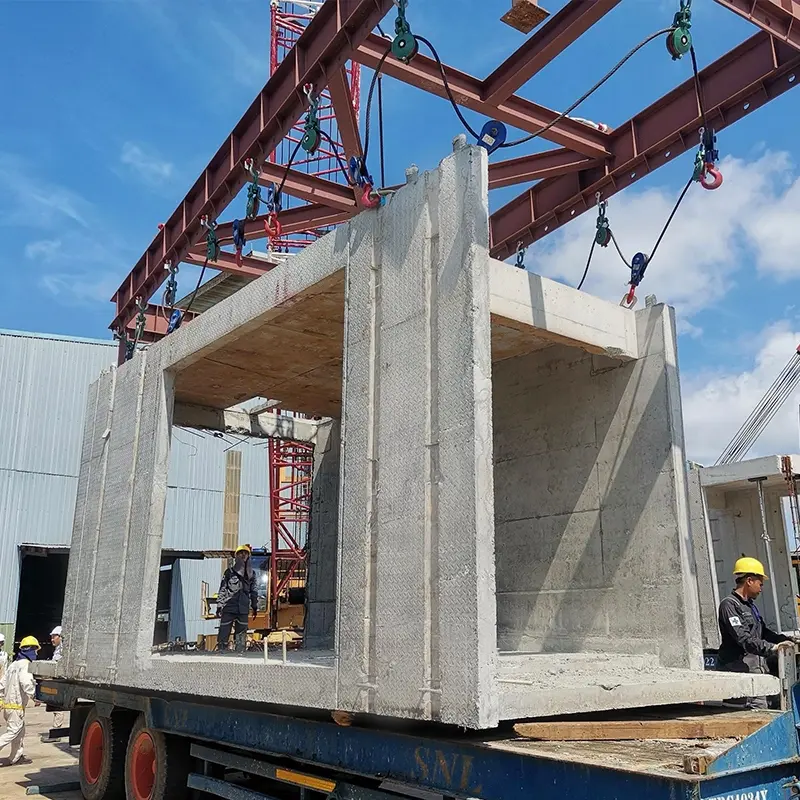In construction and maintenance work, scaffolding is a temporary structure used to support workers, materials, and equipment, ensuring safety during high-altitude tasks. It is typically made of metal or wood and provides a stable platform for workers to perform their tasks safely.
GETO Ringlock Scaffolding System
What is Scaffolding? The Meaning of Scaffolding
Scaffolding is a structure used on construction sites to support workers, tools, and building materials. Its primary purpose is to provide a safe platform to help workers perform high-altitude tasks such as building facades, repairing roofs, or moving between different levels of a building. Scaffolding allows workers to carry out various construction and maintenance jobs efficiently and safely.
In the construction field, scaffolding refers to a temporary structure that provides support and a working platform for workers during tasks such as building, maintenance, decoration, or cleaning at elevated heights. It is typically composed of vertical standards, horizontal ledgers, planks, and various connectors, forming a stable and secure framework. There are various types of scaffolding—such as tube and coupler, frame, suspended, and mobile scaffolds—chosen based on specific site conditions and project needs. The primary purpose of scaffolding is to enhance operational efficiency, ensure worker safety, and offer a stable base for tools and materials, making it an essential component in modern construction projects.
Scaffolding in construction
In construction, scaffolding refers to a temporary structure made of metal or wooden poles and platforms that provides support and access for workers and materials during the construction, maintenance, or repair of buildings and other structures. It allows workers to reach high or hard-to-access areas safely and efficiently. Scaffolding is essential for tasks like bricklaying, painting, plastering, or installing exterior components. The structure is typically assembled and disassembled on-site, and it comes in various types—such as tube and coupler, frame, cantilever, and suspended scaffolds—depending on the specific needs of the project. Its primary purpose is to ensure safety, stability, and productivity on construction sites.
How many types of scaffolding in construction?
In construction, there are several common types of scaffolding, each suited for different tasks and site conditions. The main types include:
Tube and Coupler Scaffolding
Made from steel or aluminum tubes connected by couplers (clamps).
Highly versatile and adjustable for complex structures.
Commonly used for irregular building shapes.
Frame Scaffolding (also called Prefabricated or H-Frame Scaffolding)
Consists of pre-built welded frames connected by cross braces.
Easy and quick to assemble, widely used in general construction.
Suspended Scaffolding
Platforms suspended by ropes or chains from the top of a building.
Often used for painting or window cleaning on tall buildings.
Cantilever Scaffolding
Supported at one end only, often used where the ground or floor can’t support standards.
Common in bridges or areas with obstacles.
Mobile Scaffolding
Scaffolding mounted on wheels or casters for easy movement around the site.
Used for jobs that require frequent repositioning.
System Scaffolding (Modular Scaffolding)
Prefabricated components that fit together in a standardized way.
Quick to assemble and very strong; popular for large-scale projects.
Kwikstage Scaffolding
A type of modular scaffolding widely used internationally, especially in the UK.
Features quick-locking couplers for fast assembly.
What is the purpose of scaffolding?
Scaffolding’s purpose is to provide temporary support and safe access for workers, tools, and materials during construction or maintenance, especially at heights or difficult-to-reach areas. It ensures worker safety, improves accessibility, and enhances work efficiency by offering a stable and flexible platform that can be adapted as needed throughout the project.
What is scaffolding in building construction?
In building construction, scaffolding is a temporary framework made of metal or wooden poles and platforms that provides workers with safe and stable access to elevated or hard-to-reach areas of a building. It supports workers, tools, and materials during construction, repair, or maintenance tasks such as bricklaying, painting, plastering, and cleaning. Scaffolding ensures safety, efficiency, and ease of movement on the job site, and can be assembled in various forms depending on the specific needs of the project.
Uses of scaffolding in construction
In construction, scaffolding is used to provide workers with safe and stable access to high or hard-to-reach areas for tasks such as building, repairing, painting, or cleaning structures. It supports workers, tools, and materials, enabling efficient and secure work at various heights. Scaffolding also helps improve productivity by offering a flexible platform that can be adjusted or moved as the project progresses. Additionally, it ensures safety by preventing falls and accidents, making it an essential component on most construction sites.
The Role of Scaffolding
The main function of scaffolding is to ensure safety for workers when performing tasks at heights. It provides the necessary support to prevent accidents while working. In addition, scaffolding offers space to store tools, materials, and equipment, making work more efficient. With proper design, scaffolding can improve productivity and reduce worker fatigue at construction sites.
Components of Scaffolding
Scaffolding typically consists of several basic components, including:
- Posts: The vertical parts that support the scaffold.
- Beams: Horizontal components connecting the posts, forming a stable platform.
- Planks: The surface on which workers stand while working.
- Fasteners: Parts that connect different sections.
- Safety Barriers: Guardrails or barriers to prevent workers from falling.
Types of Scaffolding
There are various types of scaffolding, each suited for different applications. Below are the most common types:
Supported Scaffolding
Supported scaffolding is the most common type, usually made of metal pipes or steel. The posts are anchored to the ground, and the platform supports both workers and materials. This type of scaffolding is ideal for most construction projects, especially those requiring long-term installation.
Suspended Scaffolding
Suspended scaffolding is hung from ropes or an electric hoist system. It is typically used for cleaning building facades or performing high-altitude repairs, especially in hard-to-reach areas.
Rolling Scaffolding
Rolling scaffolding is mounted on wheels, allowing it to be moved from one location to another. This type of scaffolding is ideal for tasks that require mobility, such as interior renovations or equipment installations.
Cantilever Scaffolding
Cantilever scaffolding extends outward from the side of a building and is used in areas without ground support. It is commonly used for external high-altitude tasks.
Safety of Scaffolding
The safety of scaffolding is critical. To avoid accidents, scaffolding installation, use, and dismantling must adhere to strict safety regulations. In many countries and regions, there are specific laws and standards governing the design, materials, and installation of scaffolding to ensure its stability and the safety of workers.
Common Safety Measures for Scaffolding
- Regular Inspections: Scaffolding must be inspected by professionals before use to ensure all parts are securely connected.
- Stable Support: Scaffolding should be placed on level ground to prevent instability.
- Use of Safety Harnesses and Guardrails: Workers should wear safety harnesses, and safety nets should be installed to prevent falls.
- Worker Training: All workers using scaffolding must undergo safety training to understand the proper usage and precautions.
Applications of Scaffolding
Scaffolding is widely used in the construction industry but is not limited to it. It also plays an essential role in other industries:
Construction and Building
Construction sites are the most common place where scaffolding is used. Whether it’s for building a new structure or renovating an old one, scaffolding provides workers with the support they need. It helps workers reach high areas safely to perform tasks like bricklaying, painting, window installation, and other exterior work.
Maintenance and Cleaning
Scaffolding is also widely used in maintenance and cleaning tasks, especially when working at great heights or in difficult-to-access areas. For example, cleaning the exterior of buildings, repairing roofs, or replacing windows all require scaffolding for safe and efficient work.
Industrial Facilities
In some industrial settings, scaffolding is used to maintain large machinery, pipe systems, and other equipment. It provides workers with a safe platform to work at heights or in complex environments.
Conclusion
Scaffolding plays a crucial role in the construction and maintenance industries by ensuring workers can work safely at heights or in difficult-to-reach places. Understanding the types of scaffolding and how to use them properly is vital for both workers and construction managers. When selecting and using scaffolding, safety should always be the top priority.
The Essential Role of Scaffolding in Construction: What It Is and Why It Matters.
Have you ever wondered how skyscrapers and bridges are built step by step? One of the unsung heroes behind the scenes is scaffolding. Simply put, the scaffolding meaning is a temporary support structure used on construction sites. It acts like a “bridge,” connecting workers to high places, allowing them to work safely and efficiently.
So, what is scaffolding in construction exactly? It’s more than just a combination of steel pipes and wooden planks—it’s a vital tool that ensures the safety and quality of the work. Scaffolding provides a stable platform for workers to carry materials, paint, lay bricks, and perform many other tasks. Without scaffolding, it would be nearly impossible for construction workers to easily reach those towering parts of a building.
That’s why understanding the scaffolding meaning and what is scaffolding in construction helps us appreciate not only the construction process but also the hard work and ingenuity of the workers. Next time you see a building rising high, remember the strong “support” behind it—the scaffolding quietly protecting every detail.
FAQ
Below are answers to common questions about scaffolding in construction:
How long does it take to set up scaffolding?
Setup time varies by project size and scaffolding type. Simple frame scaffolding may take a few hours, while complex systems like tube and coupler or GETO Ringlock can take a day or more for large structures. Professional teams ensure quick, safe assembly.
Is scaffolding safe for workers?
Yes, when installed and used correctly. Regular inspections, stable foundations, guardrails, and worker training are critical. The GETO Ringlock System enhances safety with its robust, modular design.
What is the cost of scaffolding for a construction project?
Costs depend on project size, duration, and scaffolding type. For accurate pricing, contact providers like GETO Global at https://getoformwork.com/ for tailored quotes.
Can scaffolding be reused across projects?
Yes, modular systems like GETO Ringlock are designed for disassembly and reuse, making them cost-effective and sustainable for multiple projects.
What is the difference between scaffolding and formwork?
Scaffolding supports workers and materials for access at height, while formwork shapes and supports concrete during construction. GETO Global offers both solutions for comprehensive project support.
Do workers need special training to use scaffolding?
Yes, workers must be trained in scaffolding safety, setup, and use to comply with regulations and prevent accidents. Training covers harness use, load limits, and emergency procedures.








